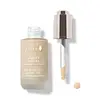What's inside
What's inside
 Key Ingredients
Key Ingredients

 Benefits
Benefits

 Concerns
Concerns

No concerns
 Ingredients Side-by-side
Ingredients Side-by-side

Titanium Dioxide 15%
Cosmetic ColorantZinc Oxide 10%
Cosmetic ColorantAloe Barbadensis Leaf Extract
EmollientOryza Sativa Starch
AbsorbentCobalt Titanium Oxide
Skin ConditioningPrunus Persica Fruit Extract
AbrasivePrunus Armeniaca Fruit
AstringentTheobroma Cacao Husk
AbrasiveHydrolyzed Lycium Barbarum Fruit
Skin ConditioningEuterpe Oleracea Fruit Oil
Skin ConditioningPunica Granatum Fruit Extract
AntioxidantTocopherol
AntioxidantEuphorbia Cerifera Cera
AstringentCamellia Sinensis Leaf
PerfumingCoffea Arabica Seed Oil
MaskingAristotelia Chilensis Seed Oil
EmollientVitis Vinifera Vine Sap
Skin ConditioningGarcinia Mangostana Amino Acids
Malpighia Punicifolia Fruit
AstringentSambucus Canadensis Extract
Skin ConditioningCitrus Grandis
Lonicera Caprifolium Flower Extract
PerfumingLonicera Japonica Flower Extract
Skin ConditioningTitanium Dioxide 15%, Zinc Oxide 10%, Aloe Barbadensis Leaf Extract, Oryza Sativa Starch, Cobalt Titanium Oxide, Prunus Persica Fruit Extract, Prunus Armeniaca Fruit, Theobroma Cacao Husk, Hydrolyzed Lycium Barbarum Fruit, Euterpe Oleracea Fruit Oil, Punica Granatum Fruit Extract, Tocopherol, Euphorbia Cerifera Cera, Camellia Sinensis Leaf, Coffea Arabica Seed Oil, Aristotelia Chilensis Seed Oil, Vitis Vinifera Vine Sap, Garcinia Mangostana Amino Acids, Malpighia Punicifolia Fruit, Sambucus Canadensis Extract, Citrus Grandis, Lonicera Caprifolium Flower Extract, Lonicera Japonica Flower Extract
Jojoba Oil/Caprylic/Capric Triglyceride Esters
Skin ConditioningHeptyl Undecylenate
EmollientSqualane
EmollientIsoamyl Laurate
EmollientMica
Cosmetic ColorantCoco-Caprylate/Caprate
EmollientSilica
AbrasiveHydrolyzed Euterpe Oleracea Fruit
Skin ConditioningArgania Spinosa Kernel Oil
EmollientVaccinium Macrocarpon Seed Oil
Skin ConditioningAloe Barbadensis Leaf Juice
Skin ConditioningTocopherol
AntioxidantPolyhydroxystearic Acid
EmulsifyingDilinoleic Acid
EmollientDisodium Stearoyl Glutamate
CleansingCI 77891
Cosmetic ColorantCI 77499
Cosmetic ColorantCI 77491
Cosmetic ColorantCI 77492
Cosmetic ColorantJojoba Oil/Caprylic/Capric Triglyceride Esters, Heptyl Undecylenate, Squalane, Isoamyl Laurate, Mica, Coco-Caprylate/Caprate, Silica, Hydrolyzed Euterpe Oleracea Fruit, Argania Spinosa Kernel Oil, Vaccinium Macrocarpon Seed Oil, Aloe Barbadensis Leaf Juice, Tocopherol, Polyhydroxystearic Acid, Dilinoleic Acid, Disodium Stearoyl Glutamate, CI 77891, CI 77499, CI 77491, CI 77492
Ingredients Explained
These ingredients are found in both products.
Ingredients higher up in an ingredient list are typically present in a larger amount.
Tocopherol (also known as Vitamin E) is a common antioxidant used to help protect the skin from free-radicals and strengthen the skin barrier. It's also fat soluble - this means our skin is great at absorbing it.
Vitamin E also helps keep your natural skin lipids healthy. Your lipid skin barrier naturally consists of lipids, ceramides, and fatty acids. Vitamin E offers extra protection for your skin’s lipid barrier, keeping your skin healthy and nourished.
Another benefit is a bit of UV protection. Vitamin E helps reduce the damage caused by UVB rays. (It should not replace your sunscreen). Combining it with Vitamin C can decrease sunburned cells and hyperpigmentation after UV exposure.
You might have noticed Vitamin E + C often paired together. This is because it is great at stabilizing Vitamin C. Using the two together helps increase the effectiveness of both ingredients.
There are often claims that Vitamin E can reduce/prevent scarring, but these claims haven't been confirmed by scientific research.
Learn more about Tocopherol